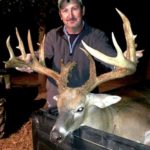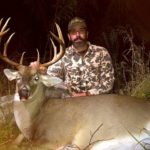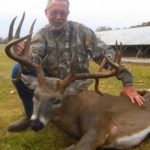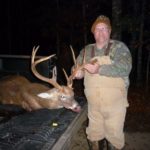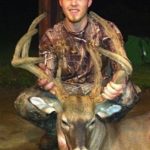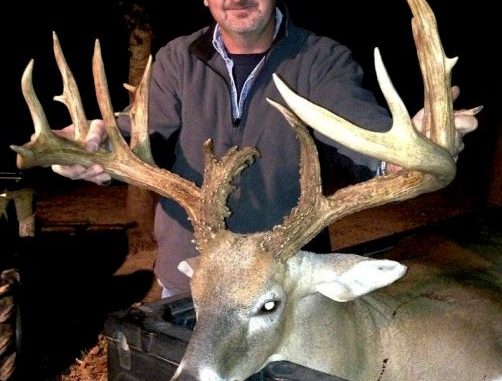
From hunting in freezing precipitation to post-season scouting, these methods are proven.
The day, Dec. 23, 1998, was nasty and getting nastier, and the weatherman’s promise of sleet and freezing rain couldn’t have been more on target, falling over the north Louisiana landscape.
Knowing the real possibility that power would soon be lost, I feverishly finished up my weekly newspaper outdoor columns before all went dark and silent. I breathed a sigh of relief when I hit the “send” button on the last article, looked at my watch and saw I had two hours of daylight left.
I jumped into my camo, grabbed my coat and rifle, and headed for my hunting lease, only a mile from home.
My first stop was a favorite box stand back in the woods. The steps were already slippery from ice, so I decided it prudent to go get in my ground blind across the lease.
I never made it to the blind.
As I eased my truck onto the abandoned power line that served as my food plot, I saw what I first thought was a cow that had somehow gotten through the fence and was busy chowing down on the clover I had planted. The “cow” raised its head and I saw antlers, big tall antlers.
Propping my rifle on the door of my truck, I squeezed off a shot and the buck bolted, traveling less than one hundred yards.
The big buck, which sported a 19¾-inch inside spread across a symmetrical 8-point rack, rough scored just a tad under 140 inches.
I learned something that chilly day that resulted in my being able to harvest the biggest buck I ever put in the crosshairs of my scope.
It tops the following list of 10 hunting tips that should be helpful to hunters in the upcoming season. The rest come from successful hunters from the 2013-14 season in Louisiana, who were willing to share the methods they used in taking big bucks.
No. 1: Hunt cold
No doubt, the icy conditions that December day contributed to my success and my trophy 8-point. Watch the weather, and when the weatherman predicts snow, sleet or ice, do everything in your power to be on your lease overlooking a good food plot as the bad weather sets in.
My guess is that I’d have never seen this buck without the ice and sleet that encapsulated the food sources. I firmly believe he came out in daylight to fill his belly before retreating to the thickets to ride out the storm.
I was there when he made his move, his big mistake, and his mount graces a special spot in my office.
No. 2: Don’t give up on a buck
On Oct. 6, 2013, bow hunter Lane Cox of Ruston arrowed an impressive 8-point buck, still in velvet, on a Tensas Parish hunt.
He and a friend were taking turns filming when the buck stepped out within bow range and it was Cox’s time to shoot. However, he was manning the camera and by the time the equipment switch was made, the buck had wandered away.
Later that afternoon, however, Cox had a second chance at the buck and this time, it paid off for him. He knows why he got that do-over.
“Don’t give up on a particular deer,” Cox said. “Staying in the blind late in the morning helped me put my eyes on the velvet buck I was after, and getting back in the blind early in the afternoon eliminated the chance of scaring any deer off. The result was I ended up bagging my deer.”
No. 3: Hunt isolated bucks early
Cox offered another helpful tip that worked on that buck: “The best time to harvest a big deer is the first two weeks of bow season when all the deer are still on their summer patterns, and, of course, during the rut.”
To be successful early, Cox used trail cams to find deer, and, just as importantly, to find deer hunters.
“One thing that helped me harvest early last year was my trail camera; putting it out (in mid July) helped me scout different areas and plan my setup,” Cox said. “When there are so many hunters in an area, I try to stay away from the heavily hunted areas that people know there are big deer. I put my cameras in several different areas. One place had three hunters around it, one area there were two, and the last place there was not a hunter as close to me as the other two areas, and that is where I had the most pictures and the best bucks.
“I had two really good bucks (145 inches-plus) and I was the only person to get pictures of one of them. I was able to put a ground blind out at the end of August to let the deer be extremely comfortable with it.”
No. 4: Don’t pressure deer
For the past five years, 68-year-old George Simolke’s trail cameras had revealed photos of a huge buck with matching drop tines on his property in Webster Parish.
Because all the photos came after sunset, the buck earned the nickname, “Nighttime Roamer.”
The big buck let his taste for rice bran get the best of him late in the afternoon of Nov. 20, 2013, when he made the fatal mistake of stepping out for a nibble as Simolke sat in his box stand 80 yards away. One shot from Simolke’s 7-mm mag, and the days of the old monarch teasing the hunter were over.
Nighttime Roamer dropped in his tracks.
With 13 scoring points, which included two almost perfectly matched dropped tines, and an inside spread of 21 ½ inches, Roamer was green scored at a whopping 187 5/8 inches.
Simolke’s tip for deer hunters has to do with hunting pressure; too much can cause a wary buck to leave an area.
“Everybody I’ve talked to said hunt the rut, hunt long and hard but do not over hunt a place,” Simolke said. “The big bucks will get on you before you get on them and they will change quickly.”
No. 5: Wind, timing always matter
Simolke offered more advice that hunters should always consider, taking it back to the basics.
“Hunt the right wind for the stand you are hunting,” he said. “If you can, hunt the major and minor periods.”
Simolke also advised against killing all the does out of an area, causing bucks to move to look for love during the rut.
No. 6: Find trophy, be patient
Simsboro hunter Mike Martin was hunting on a Claiborne Parish lease on Nov. 24, 2013, when he downed an impressive 11-point buck with a 20 ½-inch spread that green scored a whopping 170-plus inches.
Martin had seen the buck two seasons earlier, and estimated it would have scored in the 150s then. He decided to give the deer time to grow, and two seasons later he got his reward.
“To me, locating a trophy animal in North Louisiana is half the battle,” Martin said. “I could have taken this deer when he was 2½ years old; he was a respectable 16-inch deer that season. Other than trail camera pictures, I never saw him to be sure it was the same buck until he was 3½. I got three pictures total (in 2012) all at night.
“To me the other half of the equation is patience. I passed on several respectable bucks before finally getting him. I would have to say that two important essentials are locating a particular buck you want to hunt and then having the patience to hold off until you get an opportunity to take that particular deer.”
No. 7: Use video mode
On Nov. 27, 2013, John Parker, 45, who has hunted a particular Tensas Parish buck for several seasons, finally had the opportunity to put the crosshairs on the old monarch. The buck, aged at 8½ years, was indeed impressive with the most jaw-dropping characteristic being an inside spread measuring an unheard-of 28 5/8 inches. Because its unusually wide spread, it was nicknamed the “Elk” buck.
Parker’s tip?
“A good game camera set to video mode to me is important,” he said. “You get to see what you have been missing in snapshot mode. I also use what I call my ‘coffee can’ approach. I only put out a coffee can full of corn along with a Buck Bomb at each camera site.
“This year I moved three game cameras around, only putting out about a coffee can full of corn and a buck bomb each night. If you’re not seeing any good bucks in a few days, move your camera and try somewhere else until you locate a good buck.”
No. 8: Scout carefully
Lincoln Parish sheriff’s deputy Stephen Williams decided a change in plans was in order to get a shot at a big buck he’d seen on his trail camera. Since the photos only showed the buck moving after dark, Williams decided to abandon his box stand, and set up a climbing stand along the trail the buck usually followed.
Just before dark on Oct. 24, 2013, Williams used his .444 primitive firearm to dispatch the big 10-point buck, which green-scored about 150 inches.
Williams’ tip involves scouting, making sure not to give a mature buck any indication you’ve been in the area.
“One of the main things I do is I always try to leave the deer as undisturbed as possible,” Williams said. “I do most of my scouting with game cameras and never walk around looking for deer sign in the preseason. I am lucky in that I have been hunting the same areas for most of my life and I know where the scrapes, rubs and bedding areas are usually located.
“In my younger years I would walk the property once a week looking for deer and deer sign not realizing that all I was doing was disturbing the deer and pushing them off my property.”
No. 9: Post-season scouting
Williams said hunters can learn a lot about deer by doing some serious scouting after the end of deer season, when bumping the bucks is no longer a concern.
“I do all of my scouting now after deer season closes,” he said. “I have learned a lot about the deer in my area by scouting in late February and March before the green up. Another benefit to late season scouting is that I occasionally find shed antlers. This has been my best year with seven sheds found.”
No. 10: Early season best
Ferriday’s Jason Archer brought down one of Louisiana’s most impressive bucks last season, a 16-point monarch that featured 29 7/8-inch main beams, 7-inch bases with a whopping inside spread of 23 ½ inches. Those features produced a green score of 210 7/8 inches.
Archer’s tip for hunters this coming season is to be in the woods early in the season before hunting pressure intensifies.
“Hunt early in the season while deer are still in their summer pattern; bucks will still be in bachelor groups and not as wary as they will be later,” said Archer. “Early season deer are not as nocturnal. They will feed longer in daylight hours giving you a better chance of seeing them.”
Archer also recommends providing year-round food sources, either or both food plots and protein feeders, to hold deer in an area.
“One other tip is to harvest only mature or management bucks,” he said. “This will let the young bucks grow to their full potential.”
